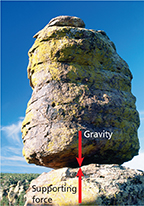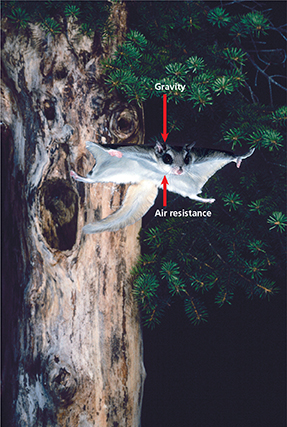Gravity
Why do leaves fall to the ground? The answer is gravity. Gravity is a force that acts between any two masses. Gravity is an attractive force, that is, it pulls objects together. Earth's gravitational force exerts a force of attraction on every other object that is near Earth. That includes you—the force of Earth's gravity holds you on the ground. Note that the force of gravity does not require objects to be in contact for it to act on them. Unlike friction, gravity can act over large distances.
 Earth's gravity acts downward toward the center of Earth. Fortunately, an upward force usually balances the downward force of gravity. What forces act on the boulder in Figure 7? Gravity pulls down on the boulder. An upward force supplied by the supporting rock acts upward and balances the downward gravitational force. Because the forces on the boulder are balanced, it remains at rest as it has for thousands of years.
Earth's gravity acts downward toward the center of Earth. Fortunately, an upward force usually balances the downward force of gravity. What forces act on the boulder in Figure 7? Gravity pulls down on the boulder. An upward force supplied by the supporting rock acts upward and balances the downward gravitational force. Because the forces on the boulder are balanced, it remains at rest as it has for thousands of years.

Figure 7 Earth exerts an attractive, downward force on this boulder.
Inferring Because the boulder is at rest, what do you know about the net force acting on it?
dFalling Objects
What forces affect the motion of a dollar bill dropped from the top of a tall building? Both gravity and air resistance affect the motion of a falling object.  Gravity causes objects to accelerate downward, whereas air resistance acts in the direction opposite to the motion and reduces acceleration.
Gravity causes objects to accelerate downward, whereas air resistance acts in the direction opposite to the motion and reduces acceleration.
In Figure 8, a flying squirrel has jumped from a tree and is falling toward the ground. As you can see, the squirrel has positioned its body parallel to Earth's surface and spread its arms and legs. By doing this, the squirrel creates a very large surface area. The large area maximizes the force of air resistance acting to slow the squirrel's downward acceleration. Because of the squirrel's slower downward acceleration, it is able to travel farther through the air than would otherwise be possible.

Figure 8 This flying squirrel takes advantage of air resistance to slow its fall and increase the distance covered in the jump.
As objects fall to the ground, they accelerate and gain speed. With increasing speed comes increasing air resistance. If an object falls for a long time, the upward force of air resistance becomes equal to the downward force of gravity. At this point, the forces acting on the object are balanced. Acceleration is zero and the object continues falling at a constant velocity. Terminal velocity is the constant velocity of a falling object when the force of air resistance equals the force of gravity. Read the Concepts in Action pages later in this chapter to learn how sky divers reach terminal velocity.




